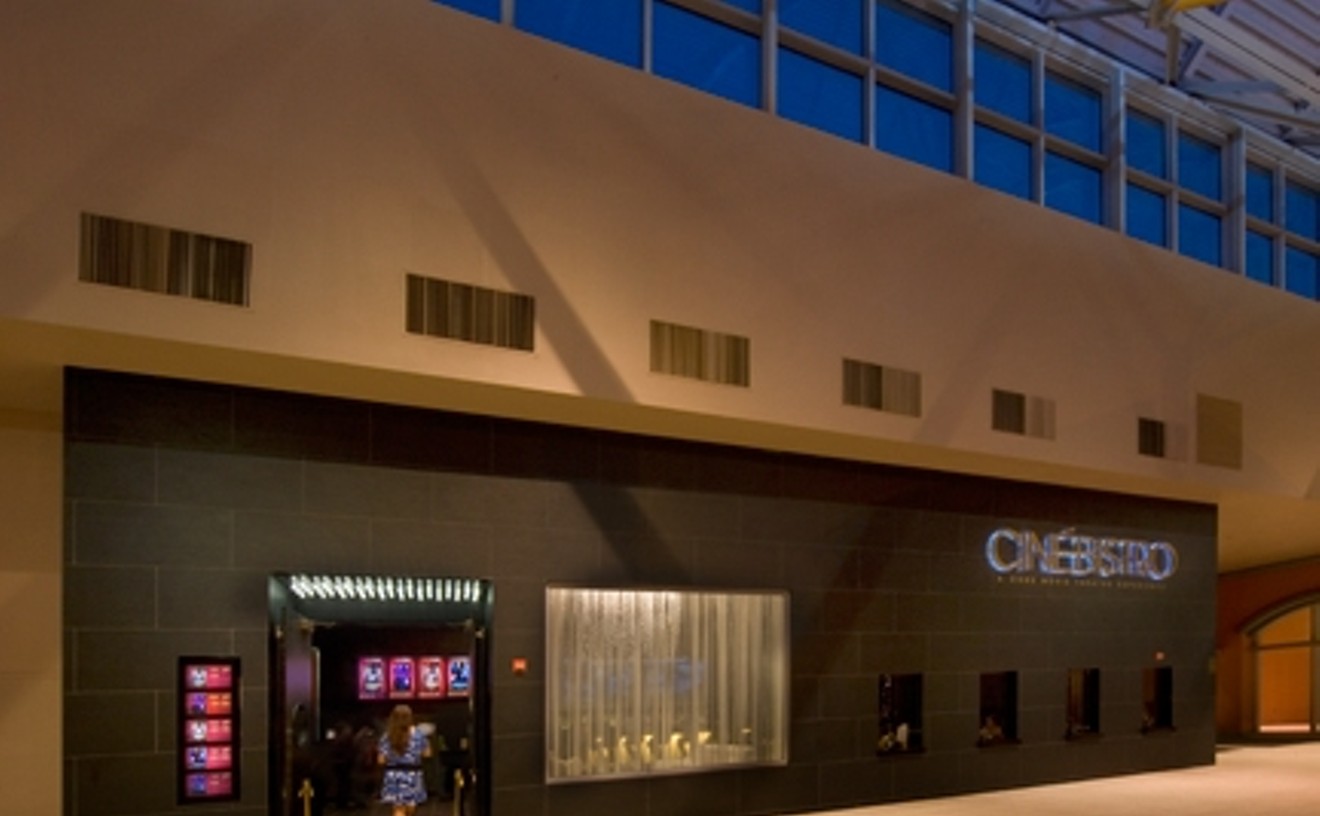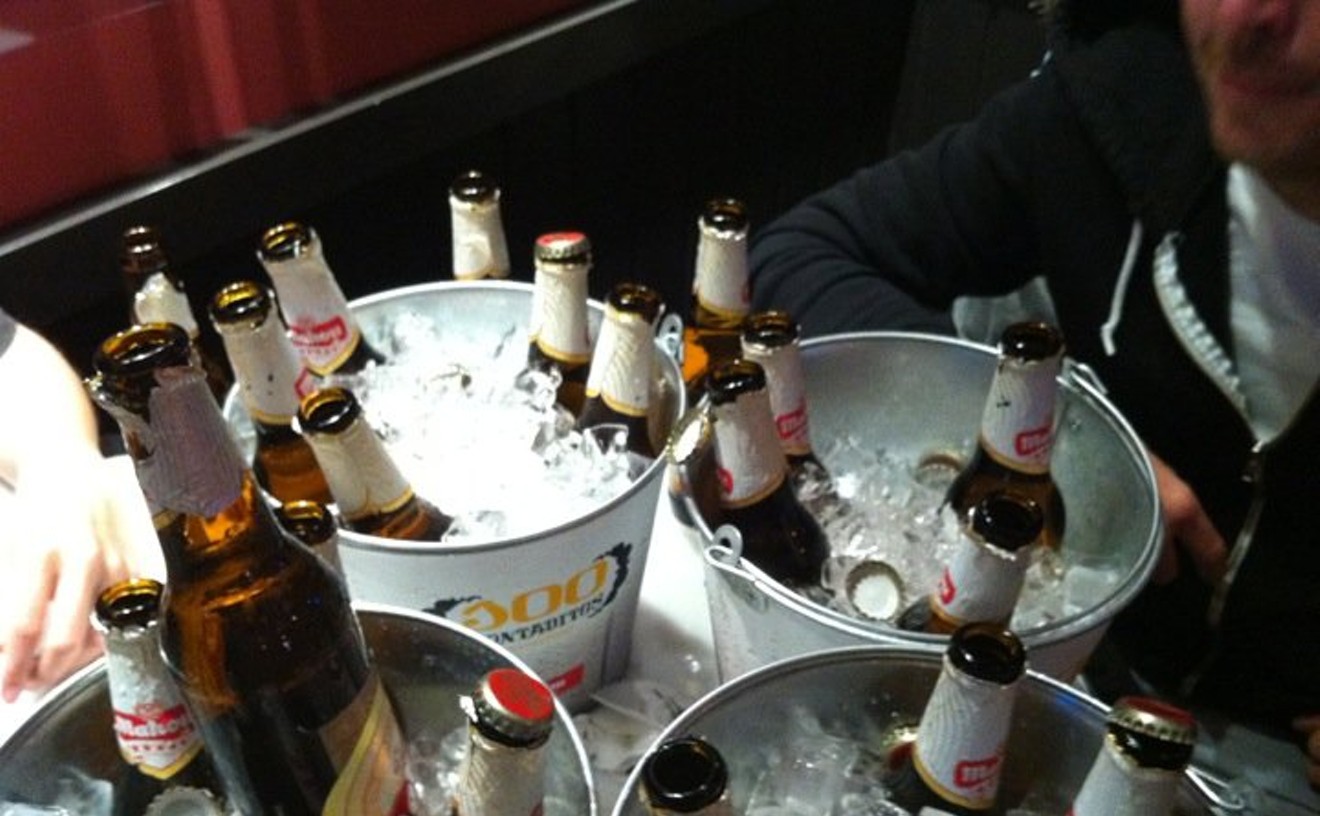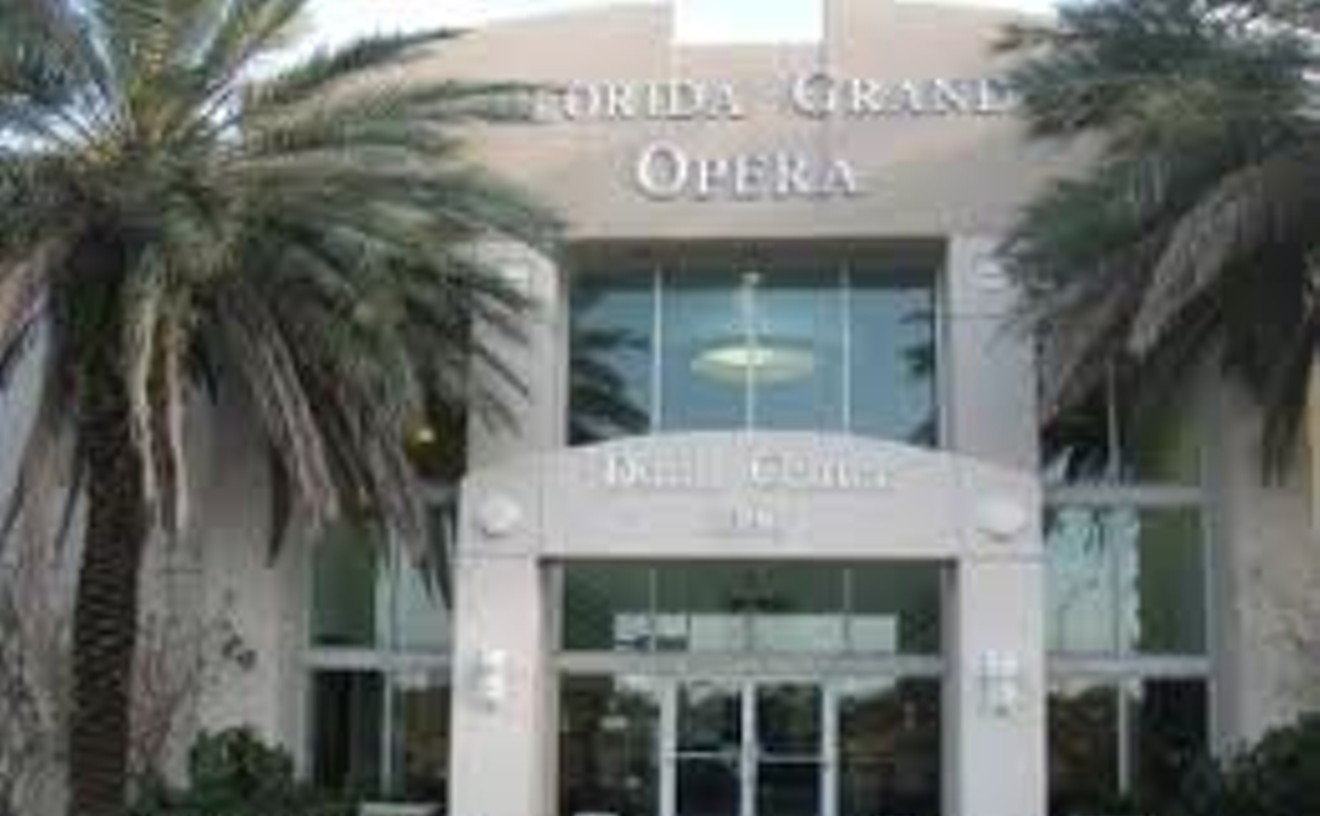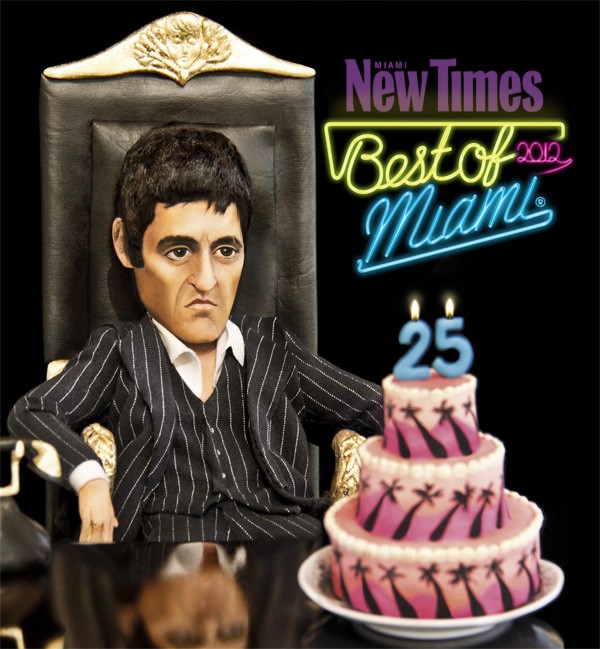Social media innovations. Flash mobs. Wynwood Second Saturday Art Walk performances. They sound like the attention-getting tactics of a young start-up arts collective. But the cultural organization that's making the biggest push for new audiences this year isn't a new one. In fact, it's been around for 71 seasons. It's Florida Grand Opera. FGO wants your ass in its audience, and it's going to great lengths to achieve it. In February, the opera's performers infiltrated Miami International Airport as part of the Knight Foundation's Random Acts of Culture. Dressed in plain clothes, they emerged from café lines and waiting areas to perform six times at gates throughout the terminals, to the delight of travelers who otherwise had nothing but stale coffee and flight delays to look forward to. FGO followed that spectacle with an announcement that was truly uncharacteristic, especially for an artistic medium as traditional as opera: The company was offering special seating at its shows for patrons who wanted to be able to use their cell phones, tablets, and other electronic devices during the performance. Tech-obsessed culture seekers could geek out to their hearts' content, sharing photos, tweeting, and even live-blogging from the shows themselves. Next came FGO's performances at the Dorsch Gallery during Second Saturday Art Walk in April, a showcase designed to appeal to an unlikely audience — hipsters. The Dorsch was packed for every performance that night. In an arts community as rapidly evolving as Miami's, innovative ideas are the only thing that'll hold anyone's interest for long.
Best Film Festival
Miami International Film Festival
At the last edition of the Miami International Film Festival, a Chilean film called Bonsái took home the big prize. But let's be honest: We were all winners. Over the course of a week and a half, we had the opportunity to watch more than 100 movies. And not just any movies — films vetted by MIFF's selection committee that were specifically designed to appeal to a local Miami audience. We got to feel pretty damn special about it too, because plenty of those movies made their South Florida premiere, their U.S. premiere, their North American premiere, and, yes, even their very first screening anyplace in the world right here in the Magic City. (The Showtime TV drama Magic City also hosted a red-carpet screening of its pilot episode at this year's fest.) The Miami International Film Festival is the biggest movie party in town in terms of numbers of films, special events, and celebrities who trek to the tropics for red-carpet appearances and post-screening Q&A sessions. Though we love the other, more niche-focused festivals that come through town each year, MIFF is the one that offers the broadest vision of the world from a South Florida point of view. That's a vision that's hard to beat.
Best Art-House Cinema
O Cinema
Miami's art-house scene has grown exponentially over the past year, and O Cinema is leading the way. The Wynwood theater, which opened only two years ago, is already keeping up with its peers in the 305, bringing national and international indie films to town. In the past 12 months, it has shown off buzz-worthy festival favorites such as Lars von Trier's Melancholia and niche films like Tomboy, which made waves on the GLBT scene. But it's O Cinema's focus on Miami — both its filmmakers and its audience — that sets this art house apart. From the best of the Borscht Film Festival's shorts, to a documentary featuring the badass local NSFW rapper Blowfly, to March's ten-year Rakontur retrospective, O is clearly devoted to showing off our city. And not just its film side — the theater's OMG Dinner and a Movie series lets viewers pig out on food by local chef gone big Michael Schwartz, making it the only theater in Miami where you can enjoy a bona fide dinner (read: not just popcorn and hot dogs) with your show. The folks at O Cinema clearly love the Magic City as much as we do, and that only makes us love them more.
Best Movie Theater
CineBistro at Dolphin Mall

Dinner and a movie. It's been a classic date combo since the early days of the silver screen. You fill up on tasty food, take in a rom-com while you digest, and if all goes well, return home to get it on. But this is Miami, where all rarely goes well. Traffic sucks, you can get caught in a rainstorm at any second, and public transportation is essentially nonexistent — all of which means getting you and your date from the restaurant to the movie theater can be a frustrating, and potentially sex-sabotaging, process. Unless, that is, you've taken your date to CineBistro, where the restaurant is the movie theater and vice versa. CineBistro shows all the big-name movies you'll find at every other theater in the 305. But show up at the Dolphin Mall location at least 30 minutes before showtime and you can select from a full menu of appetizers, main courses, and desserts to eat while you watch. There's also booze galore: wine, beer, and specialty cocktails. So you get to watch a movie with a real drink in your hand, as opposed to a Sprite bottle filled with vodka that you smuggled in. And you won't have to worry about kids crying or shuffling off to the bathroom every five minutes, because this theater doubles as a bar, so CineBistro movies are 21-plus only. It all adds up to the most convenient, hassle-free movie experience in Miami — getting there, getting fed, and getting through a whole feature film without annoyances. Getting laid afterward is, of course, up to you.
- 11471 NW 12th St., Miami, 33172-6900 Map
- 305-455-7373
- cmxcinemas.com
Best Pop-Up Event
Live Young, Skate On!
What elevates a random gathering of people to "pop-up event" status? In the case of Live Young, Skate On!, it was a couple of things: Live entertainment, celebrity appearances, and a world record to break. Evian invited all Miamians to converge on Collins Park this past April 7 for a pop-up roller-skating party, complete with free skates, backpacks, and freaky T-shirts designed to make participants look like their heads were attached to the bodies of infants. Folks from all walks of life signed up, from wobbly-legged skating beginners to the Roll Crew team, whose members showed off with handstands and other crazy tricks on wheels. A DJ spun '80s hits, and the CoolHaus ice-cream truck served frozen treats. Actress Gabrielle Union even made an appearance, joining a roller skate conga line. Union's participation alone certainly made Live Young, Skate On! the pop-up event of the year for at least one attendee (the guy who got to skate behind her with his hands on her hips, naturally). But the rest of the participants had an awesome time too. Amid the retro fun of roller skating, watching Roll Crew's stunts, and taking goofy pictures in the free photo booth, they set a record for world's longest roller-skating conga line — verified by on-site RecordSetter officials to be 197 people — making Live Young, Skate On! a pop-up event that will go down in history.
Best Party Venue
Villa 221

At the end of every lunar month (approximately 29.53 days), a beautiful downtown Miami mansion was overrun by hard-core Earth fanatics, semi-ironic hippies, and amateur astrology enthusiasts who came to worship that bright, white rock in the sky by flipping tarot cards, syncing menstrual cycles, peddling homemade holistic anklets, instigating furious drum circles, and dancing barefoot till Mother Moon revealed the secrets of the universe. Yes, it was a full-moon party. And until recently, it went down at Villa 221, a palatial 8,500-square-foot nightlife compound within drunken-stumbling distance of the Burger King and Checkers on Biscayne Boulevard at NE 17th Street. Of course, a Villa party isn't always about barefoot worshipers passed out on comfy circular sofas and making out in the moonlight. The recently restored 1920s Spanish-style estate also caters to scuzzy SoFla scenesters, international EDM jet-setters, and entertainment industry pros by hosting local record releases, marathon 16-hour raves during Winter Music Conference and Miami Music Week, and even New Times' own Artopia bash this year. The Villa is the exceedingly rare place where lunar-deity devotees, long-haired hipsters, ecstatic fist-pumpers, alt-weekly writers-for-hire, and even Mother Moon herself can party together in perfect harmony.
- 221 NE 17th St., Miami, 33132 Map
- 305-416-5280
- villa221.com/Home.html
Best Author
Ana Menendez
Ana Menéndez's fourth book, Adios, Happy Homeland!, is structured as a collection of stories by Cuban writers spanning several decades. Though the stories are presented as unrelated, each one slyly shifts into the next and the different voices build to a chorus trying to make sense of what it is to leave home. The book isn't about where people come from but where they go when their homeland ceases to be their own. One boy thinks Miami is "someplace in the sky" after his father "turned him to face the smell of the ocean and pointed up through the leaves, [saying,] 'Miami is that way.'" Elián González haunts several sections, but otherwise the book points outward from Cuba in as many directions as there are stories. Grifters import luxury chocolates instead of food for children, Miami office drones swap Castro speeches for cubicle-tacked slogans ("Become a possibilitarian!"), and men back in Cuba grow wings. Borges and Bolaño are obvious influences, and though Cuba is present on every page, this is a book of and about Miami. Menéndez spent years as a Miami Herald reporter and columnist, but she wrote most of this book in the Netherlands and continues to split her time between Maastricht and Miami. Her work offers a stunning glimpse of a city often too occluded by its own magic to be seen from within. It's an essential read for anyone who has forgotten the many ways Miami shifts to fit the dreams of its every new arrival.
Best Actor
Gregg Weiner
Gregg Weiner is the only South Florida-based actor who has the stage presence and physical instincts to sink himself into the skin of such a force of nature as Mark Rothko, the brilliant Russian-born American expressionist who's the subject of John Logan's one-act, semibiographical play Red. With a shaved head and middle-aged paunch, Weiner was grounded yet forceful as Rothko — a man so fraught with conviction he can't help but bludgeon his young assistant with overbearing speeches about art and its role as myth in society. Rothko could be an imperious, domineering personality, but Weiner, with his artful baritone inflection, nuanced humor, and genuine humanity, made the ornery artist a likable and oftentimes sympathetic figure. It's not easy bringing a troubled genius to life before a live audience night after night. It takes a robust, bombastic, yet adaptable actor to become someone like Rothko, yet Weiner pulled it off masterfully, and the result was another triumph for GableStage.
- 1200 Anastasia Ave., Coral Gables, 33134 Map
- 305-446-1116
- www.gablestage.org
Carl Hiaasen — South Florida's reigning king of fiction that's almost as unbelievable as local headlines — once said of his novels' bad guys: "I always try to burden even the villains with some weird predilection they have to cope with. It helps make them memorable and gives them a human side." Former drug smuggler Jon Roberts, who achieved an outlaw's fame when he costarred in the documentary Cocaine Cowboys, was as gleefully villainous as any literary character. He was a mob thug turned Vietnam War murderer — readily admitting to skinning Vietcong alive and killing village women and children — turned filthy rich and incredibly violent coke importer. He once eluded cops by kicking through the windows of two squad cars, while handcuffed, leaving a trail of hundred-dollar bills behind him. Hell, in 2009, he threatened the life of a reporter from this publication. But in his memoir, American Desperado, his co-author, accomplished war journalist Evan Wright, somehow dragged enough weird predilections out of Roberts to make the old, evil bastard sympathetic. At one point, Roberts, an unlikely animal lover, recalled his deep fondness for a glass room he constructed in his Delray Beach house. During wild South Florida electrical storms, he liked to lie there with his model wife, his 150-pound pet cougar named Cucha, and his killer dogs, and watch rain lash the glass. He had spent his teenage years as a bloodthirsty orphan after his mafioso dad was deported and his mother passed away. Roberts died in horrible, karmic fashion from the rapid spread of cancer a month after the memoir was published. But the sparely described image of him ensconced behind glass with his strange, makeshift family, marveling at the natural power of a storm, said something about the swaggering bad guy's perpetual loneliness. And, even more remarkably, about his vulnerability.
Best Miami Herald Reporters
Michael Sallah and Carol Marbin Miller
This year, the Miami Herald was a Pulitzer finalist for its series "Neglected to Death," about horrifying abuse and deadly neglect in Florida's assisted living facilities. The series was reported by Michael Sallah and Carol Marbin Miller — along with Rob Barry, who has since left the paper — and as a result of their yearlong investigation, 13 offending facilities were shut down and the state penalized nearly three dozen others. Lives were saved — lives of otherwise marginalized, voiceless, defenseless people like so many of the others whose stories were told in "Neglected to Death." Is there a better use of newsprint than that? As important as this series has been, it's worth noting that it isn't unlike the other work Sallah and Marbin Miller have produced during their careers. Sallah has won two Pulitzers for reporting on war crimes and public housing corruption, and Marbin Miller has done incalculable good in chronicling child welfare problems in the state. If you see either of their bylines above an article, it's a safe bet that what follows is essential reading that will reverberate in Florida well past the final punctuation mark.
- 3511 NW 91st Ave., Doral, 33172 Map
- 305-350-2111
- miamiherald.com






